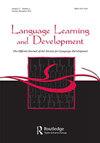The Impact of Phonological Biases on Mispronunciation Sensitivity and Novel Accent Adaptation
IF 1.4
2区 文学
0 LANGUAGE & LINGUISTICS
引用次数: 1
Abstract
ABSTRACT Successful word recognition requires that listeners attend to differences that are phonemic in the language while also remaining flexible to the variation introduced by different voices and accents. Previous work has demonstrated that American-English-learning 19-month-olds are able to balance these demands: although one-off one-feature mispronunciations typically disrupt English-learning toddlers’ lexical access, they no longer do after toddlers are exposed to a novel accent in which these changes occur systematically. The flexibility to deal with different types of variation may not be the same for toddlers learning different first languages, however, as language structure shapes early phonological biases. We examined French-learning 19-month-olds’ sensitivity and adaptation to a novel accent that shifted either the standard pronunciation of /a/ from [a] to [ɛ] (Experiment 1) or the standard pronunciation of /p/ from [p] to [t] (Experiment 2). In Experiment 1, French-learning toddlers recognized words with /a/ produced as [ɛ], regardless of whether they were previously exposed to an accent that contained this vowel shift or not. In Experiment 2, toddlers did not recognize words with /p/ pronounced as [t] at test unless they were first familiarized with an accent that contained this consonant shift. These findings are consistent with evidence that French-learning toddlers privilege consonants over vowels in lexical processing. Together with previous work, these results demonstrate both differences and similarities in how French- and English-learning children treat variation, in line with their language-specific phonological biases.语音偏差对错误发音敏感性和新口音适应的影响
成功的单词识别要求听者注意语言中音位的差异,同时对不同的声音和口音所带来的变化保持灵活。先前的研究表明,学习美式英语的19个月大的婴儿能够平衡这些需求:尽管一次性的单一特征发音错误通常会扰乱学英语的幼儿的词汇获取,但当幼儿接触到一种新的口音后,这些变化就不再发生了。然而,对于学习不同第一语言的幼儿来说,处理不同类型变化的灵活性可能并不相同,因为语言结构会形成早期的语音偏见。我们研究了学法语的19个月大的婴儿对一种新口音的敏感性和适应性,这种口音要么将/a/的标准发音从[a]变成[j](实验1),要么将/p/的标准发音从[p]变成[t](实验2)。在实验1中,学法语的幼儿将/a/发音为[j]的单词识别为[j],而不管他们之前是否接触过含有这种元音移位的口音。在实验2中,幼儿在测试中不能识别出/p/发音为[t]的单词,除非他们首先熟悉含有这种辅音转移的口音。这些发现与学法语的幼儿在词汇处理中优先考虑辅音而不是元音的证据一致。结合之前的研究,这些结果显示了学法语和学英语的儿童对待变化的差异和相似之处,这与他们的语言特定语音偏见是一致的。
本文章由计算机程序翻译,如有差异,请以英文原文为准。
求助全文
约1分钟内获得全文
求助全文

 求助内容:
求助内容: 应助结果提醒方式:
应助结果提醒方式:


